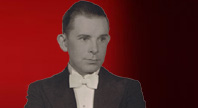

![]()
“The Knot of Enchantment” (1915)
One of the earliest memories Stewart James wrote about regarding his interest in magic was performing “The Knot of Enchantment” while standing on the verandah of the house where he was born. Sadly, neither of his parents encouraged his interest in magic. This rope trick, which the seven-year-old Stewart learned from a copy of Boy’s World magazine, is a revealing snapshot of the magician’s early family life and of his first experience thinking seriously about a piece of magic. Stewart James had a difficult and lonely childhood, but tricks like “The Knot of Enchantment” allowed him to resist and elude that painful reality. As a boy, he was often restricted to his bedroom’s veranda, because his mother and father severely limited his wanderings. His mother in particular was overprotective and believed Stewart was a “sickly” child (ES 2). Due to the domineering influence of his parents Stewart only attended school from the ages of seven to fifteen. He was rarely allowed to play with other children and spent an unusual amount of time by himself as he matured. Because he was denied playmates his age in real life, magic became a hobby which Stewart practiced with imaginary friends: “When I became interested in magic, I escaped to the world of my imagination and my friends who lived there. We worked out tricks together” (ES 2). Out of necessity, and from the age of seven onwards, Stewart used magic as an alternative source of entertainment and diversion. “The Knot of Enchantment” clearly illustrates how studying magic provided little Stewart with the companionship, the creative escape and the self-confidence his parents refused him as a young boy. Due to the strict limitations imposed by his mother’s overbearing personality, by his father’s insecurity about not understanding Stewart’s tricks and by his parent’s collective dislike for magic, he had a great need to invent imaginary friends and alternative methods for his magic effects. This unusual hobby rewarded his creative efforts with a sense of control; it gave him a fantastic, private universe to which he could escape; in that alternate reality, he could visit his friends as often as he liked. Furthermore, the necessity for invention created by the circumstances of his childhood forced Stewart to think outside of the box in more ways than one. Stewart’s first rope trick had a significant impact on what would eventually become an identifying characteristic of his philosophical approach to magic. “’The Knot of Enchantment’ was an influence on my thinking in magic, and a major cause of my interest in principles, not just tricks” (ES 2). The modus-operandi of this particular trick, whose effect is the seemingly impossible appearance of a knot in the centre of a rope attached to the magician’s wrists, and whose method is described in Stewart James’ Encyclopedia of Rope Tricks, is not accomplished using a sleight-of-hand technique; instead, the knot is able to magically appear thanks to physics – a field of science which provides magic with many little known principles of deception. Later on in life, Mr. James continued to privilege what are known as “self-working” magic tricks (the antithesis of what could be called “sleight-heavy” magic). This attitude is a direct contradiction of a strong, traditional bias espoused by the majority of professional magicians. Many mainstream performers disagree with James and consider self-working tricks to be less impressive or even inferior to “advanced” magic effects which demand dexterous manipulation. Such magicians focus on mastering techniques and measure their skill based on the number of difficult moves they are able to execute. In 1915, however, a young, impressionable Stewart James learned a trick which alleviated some of the uneasiness he felt at home and also sparked his interest in an often ignored area of the performing art – the study of magic principles.
|
Copyright © 2007 Joe Culpepper and Magicana. All rights reserved.